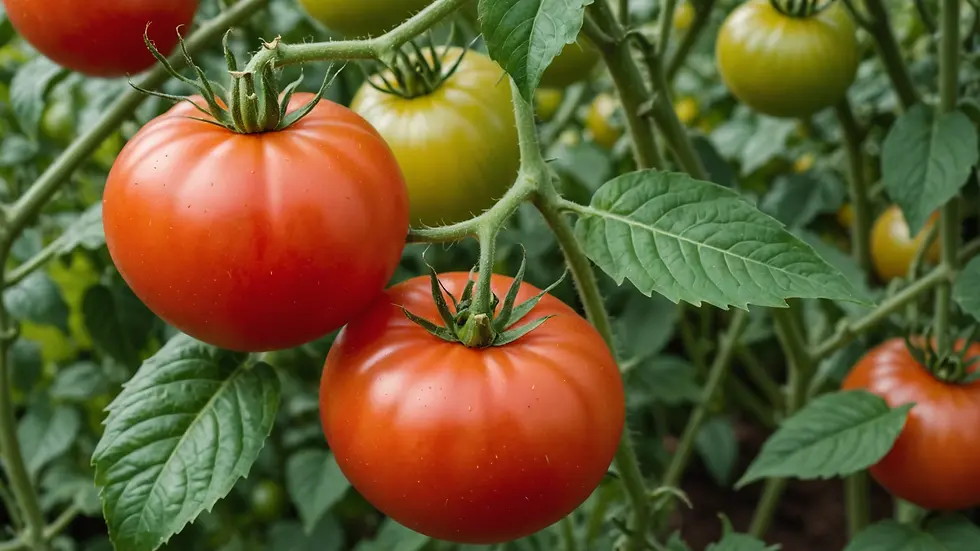Uncover the Thrilling World of Homegrown Gardens: Embracing the Unknown in Growing Your Own Food
- gpgardendesign
- Dec 30, 2024
- 4 min read
Growing your own food is an exciting adventure full of anticipation, discovery, and satisfaction. From the thrill of seeing a seed sprout in the spring to the joy of tasting a freshly picked tomato, home gardening offers much more than just food; it provides a connection to nature and the pleasure of nurturing life. Let's journey into the vibrant world of homegrown gardens and discover the secrets of cultivating your own fruits and vegetables. The following text focuses prominently on the growing region of central and southern England/Wales.
The Joy of Growing Your Own Food
Studies indicate that homegrown food is often 50% richer in nutrients than shop-bought produce. Not only does homegrown food taste better, but it is also free from harmful pesticides and chemicals, providing peace of mind alongside delicious flavours.
Additionally, engaging with your garden can greatly enhance your mental wellness. Research shows that spending even 30 minutes in nature can reduce stress levels by nearly 60%. Every time you plant a seed, you’re planting a source of further joy and tranquillity in your garden.
Essential Steps to Start Your Homegrown Garden
1. Choosing the Right Space
The first step in growing your food is selecting the ideal spot for your garden. Your plants (on average) need at least 6 to 8 hours of sunlight each day to thrive. Look for areas in your garden that are not only sunny but also shielded from harsh winds and have easy access to water.
If space is tight, consider container gardening. You can successfully grow leafy greens, herbs, and even peppers in pots on your balcony or windowsill, making it easier to enjoy homegrown food without a garden.
2. Selecting What to Grow
Choosing what to plant can be the most enjoyable part of starting your garden. Thinking about what you typically like to cook is a great way of influencing what you grow. If you want easy-to-grow options, consider radishes, lettuce, or zucchini. Growing a variety of plants can provide a great opportunity for you to get creative in the kitchen and cook seasonal meals.
For Spring and Summer, consider sewing Tomatoes, Salad Greens (Lettuce, Spinach, Rocket, Mizuna), Peas, Carrots, Courgettes (Zucchini), Beans (Broad Beans, Runner Beans, French Beans), Cucumbers, Radishes, Sweetcorn and Kale.
For Autumn and Winter, consider growing Brussels Sprouts, Cabbage (Savoy, Spring, and Winter Varieties), Leeks, Swedes (Rutabaga), Turnips, Winter Carrots, Parsnips, Spinach (Winter Varieties), Brassicas (Broccoli, Cauliflower, and Calabrese)
According to the USDA, gardening can yield a return of 1.5 to 3 times your initial investment based on what you grow. Take the time to research what grows well in your area and select a mix of crops that will thrive and bring you joy.
3. Preparing Your Soil
Quality soil is the heart of a successful garden. Testing the soil is hepful to understand its pH and nutrient levels. You can buy a soil testing kit at any local gardening store.
Once you test your soil, improve it by adding organic matter, such as compost. Healthy soil not only nourishes your plants but also improves water retention—crucial for hot summer months. Aim for soil that is loamy, dense with nutrients, and well-drained.
4. Seed Planting Techniques
Now, your space and soil are ready for planting! Read the seed packets to get specific details on planting depth and spacing. For instance, beans need about 1 inch of soil above them and should be spaced about 2 inches apart.
Follow these guidelines to ensure that your plants have ample room to grow and access nutrients. You should also consider starting some seeds in a greenhouse to get a head start on the gardening season. This is a great idea during the late winter months in preparation for the spring growing period.
5. Caring for Your Plants
Caring for your plants involves regular watering, weeding, and monitoring them for pests and diseases. Use mulch to retain moisture and reduce weed growth, which can compete with your plants for nutrients.
Avoid harmful chemicals by using natural solutions. For example, companion planting—growing beans with corn, which can enhance growth and discourage pests. Additionally, flowers like marigolds can repel certain insects, providing a natural moat around your edible plants.
Harvesting: The Ultimate Reward
The moment of harvest is fulfilling beyond measure! Picking your first ripe tomato or gathering fresh leafy greens is an experience you will cherish. It is vital to know the right time to harvest; fruits and vegetables should be picked when fully ripe for the best flavour.
Experiment with different harvesting techniques to enhance your yield. For instance, picking herbs in the morning can yield a richer flavour.

Embracing the Unknown
Gardening is a journey filled with unexpected challenges and surprises. Each season will teach you something new—some plants may not grow as expected or pests may invade your garden.
Engaging with fellow gardeners can be incredibly beneficial. Join online gardening forums, local clubs, or social media groups to share experiences, advice, and solutions to common problems. Connection can enrich your gardening journey.
Allowing for Trial and Error
Mistakes are part of the gardening experience. Perhaps your zucchini did not produce as expected, or your carrots grew deformed. Each hiccup offers learning opportunities that will help you become a more skilled gardener. Embrace these lessons as essential steps on your path to gardening success.
Start Your Homegrown Journey
Embarking on the journey of growing your own food is exhilarating and enriching. You cultivate life, nurture your mental well-being, and connect with nature.
Whether you have a spacious garden or a small balcony, there is always room for a homegrown garden. Dive into this adventure by planting seeds, caring for your plants, and savouring the fruits of your labour. Beautiful surprises await just below the surface, waiting for you to discover them!
Be bold and take that first step in the new year—embrace the unknown in the rewarding world of homegrown gardens! Now is the perfect time to get started. Happy gardening!
_edited.png)





Comments